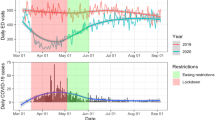Abstract
Objective
Social assistance helps fulfill the basic needs of low-income individuals. In British Columbia, social assistance is issued on the third or fourth Wednesday of every month. However, this sudden influx of resources may have negative health consequences. We investigated social assistance timing and emergency department (ED) visits related to trauma, mental health, and substance use.
Methods
We conducted a retrospective multi-centre observational study using 12 years of regional ED data from Vancouver, British Columbia (2008–2020). Each cheque week (the week following social assistance disbursement) was matched to a single control week (2 weeks prior to cheque week). We compared the number of ED visits for trauma, mental health, and substance use during cheque weeks versus control weeks.
Results
There were 253,360 visits during all weeks of interest. Cheque week was associated with significantly more ED visits for mental health and substance-related presentations (RR 1.07, 95% CI 1.03–1.11, p = 0.0006). These visits increased significantly for both males and females and for adults aged 17–64 years. Mental health and substance-related visits increased on the day of cheque disbursement (Wednesday) and the 4 days following (Thursday–Sunday). Trauma-related ED visits were elevated on the day of cheque disbursement, but not during other days of the week.
Conclusions
Social assistance disbursement is followed by an increase in mental health and substance-related ED presentations and may be associated with an increase in trauma presentations on the day of cheque disbursement. These findings support calls for clinical and policy-level changes and support to reduce cheque day-associated harm.
Résumé
Objectif
L'aide sociale permet de répondre aux besoins fondamentaux des personnes à faible revenu. En Colombie-Britannique, l'aide sociale est versée le troisième ou le quatrième mercredi de chaque mois. Cependant, cet afflux soudain de ressources peut avoir des conséquences négatives sur la santé. Nous avons étudié le calendrier de l'aide sociale et les visites aux urgences liées aux traumatismes, à la santé mentale et à la toxicomanie.
Méthodes
Nous avons mené une étude d'observation rétrospective multicentrique en utilisant 12 années de données sur les urgences régionales de Vancouver, en Colombie-Britannique (2008-2020). Chaque semaine de chèque (la semaine suivant le versement de l'aide sociale) a été appariée à une seule semaine de contrôle (deux semaines avant la semaine de chèque). Nous avons comparé le nombre de visites aux urgences pour traumatisme, santé mentale et toxicomanie pendant les semaines de chèque et les semaines de contrôle.
Résultats
Il y a eu 253 360 visites pendant toutes les semaines d'intérêt. La semaine des chèques a été associée à un nombre significativement plus élevé de visites aux urgences pour des présentations liées à la santé mentale et à la toxicomanie (RR 1,07, IC 95 % 1,03-1,11, p = 0,0006). Ces visites ont augmenté considérablement chez les hommes et les femmes et chez les adultes de 17 à 64 ans. Les visites liées à la santé mentale et aux substances ont augmenté le jour du versement du chèque (mercredi) et les quatre jours suivants (jeudi – dimanche). Les visites aux urgences liées à un traumatisme étaient plus nombreuses le jour de la remise du chèque, mais pas les autres jours de la semaine.
Conclusions
Le versement de l'aide sociale est suivi d'une augmentation des présentations aux urgences liées à la santé mentale et à la toxicomanie et peut être associé à une augmentation des présentations de traumatismes le jour du versement du chèque. Ces résultats appuient les appels à des changements et à un soutien au niveau clinique et politique afin de réduire les préjudices associés au jour du chèque.

Similar content being viewed by others
References
Nelson K. Mechanisms of poverty alleviation: anti-poverty effects of non-means-tested and means-tested benefits in five welfare states. J Eur Soc Policy [Internet]. 2004;14(4):371–90. https://doi.org/10.1177/0958928704046879.
Income Assistance Payment Dates—Province of British Columbia [Internet]. https://www2.gov.bc.ca/gov/content/family-social-supports/income-assistance/payment-dates. Accessed 18 Jan 2021
Rosen MI. The ‘check effect’ reconsidered. Vol. 106, Addiction. Oxford: Blackwell Publishing Ltd; 2011. p. 1071–7.
Verheul G, Singer SM, Christenson JM. Mortality and morbidity associated with the distribution of monthly welfare payments. Vol. 4, academic emergency medicine. Oxford: Blackwell Publishing Ltd; 1997. p. 118–23.
British Columbia Centre on Substance Use. The Cheque Day Study community impact statement: perspectives on changing the timing and frequency of income assistance payments [Internet]. Vancouver, BC: British Columbia Centre on Substance Use. May 2019. https://www.bccsu.ca/wp-content/uploads/2019/06/Cheque-Day-Study-Community-Impact-Statement.pdf. Accessed 18 Jan 2021
Grafstein MDE, Bullard MDMJ, Warren MDD, Unger MDB. Revision of the Canadian Emergency Department Information System (CEDIS) presenting complaint list version 1.1. CJEM J Can Assoc Emerg Physicians [Internet]. 2008;10(2):151–73.
R Core Team. R: A language and environment for statistical computing. [Internet]. R Foundation for Statistical Computing. 2018. https://www.r-project.org/. Accessed 1 May 2020
Riddell C, Riddell R. Welfare checks, drug consumption, and health. Vol. 41, Journal of Human Resources. Madison: University of Wisconsin Press; 2006. p. 138.
Galea S, Nandi A, Vlahov D. The social epidemiology of substance use. Epidemiol Rev. 2004;26:36–52.
McCarthy ML, Zeger SL, Ding R, Levin SR, Desmond JS, Lee J, et al. Crowding delays treatment and lengthens emergency department length of stay, even among high-acuity patients. Ann Emerg Med. 2009;54(4):492-503.e4.
Funding
None.
Author information
Authors and Affiliations
Contributions
SLB was responsible for study concept and drafting of manuscript. SE was responsible for data analysis. SLB, JRB, SE, JAS, and HC were responsible for study design and analytic strategy. JRB was responsible for acquisition of data, and SLB, JRB, and SE had full access to all study data. All authors were responsible for critical revision of the manuscript.
Corresponding author
Ethics declarations
Conflict of interest
No conflicts of interest.
Supplementary Information
Below is the link to the electronic supplementary material.
Rights and permissions
About this article
Cite this article
Bao, S.L., Erdelyi, S., Chan, H. et al. The association between monthly social assistance disbursement days and emergency department visits for trauma, mental health, and substance use. Can J Emerg Med 23, 673–678 (2021). https://doi.org/10.1007/s43678-021-00115-w
Received:
Accepted:
Published:
Issue Date:
DOI: https://doi.org/10.1007/s43678-021-00115-w




